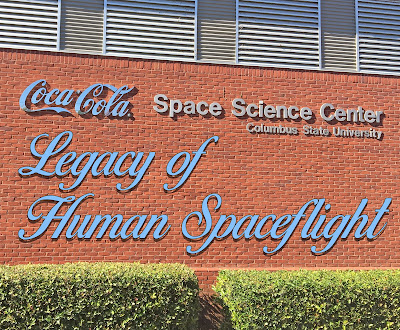With all of the space excitement in
November, I'm delayed in writing about this great local news: the
opening of the Legacy of Human Spaceflight exhibit at Columbus State
University's Coca-Cola Space Science Center.
My son Leo and I spent the morning of
November 10 in Columbus, Georgia as a guest for the ribbon cutting.
Among the announcement: Apollo astronaut Fred Haise will be a special
guest at the museum next July for the 50th anniversary of the Apollo
11 Moon landing.
 |
| My fellow museum explorer Leo strapped in for the ride. |
Museum Executive Director Shawn Cruzen
gave us the first tour. He described every item in the new exhibit
with pride. This was my first visit to the museum so I was grateful
for the explanations. Even though it was a replica, my favorite item
was the Coca-Cola dispenser flown on the space shuttle before we
realized carbonated beverages and microgravity don't mix.
 |
| Getting a first look at the new exhibit. |
 |
| Executive Director Shawn Cruzen giving the first tour. |
 |
| Replica of a microgravity Coca-Cola dispenser |
Shawn was very excited to show us the
exhibit donated by the brother of Apollo and Gemini astronaut Dave
Scott and the mission control sign that will soon be backlit
illuminated. I noted many personal touches among the donated
artifacts.
 |
| Artifacts donated by Dave Scott's brother |
After the tour, Leo and I explored the
rest of the museum, which didn't take long because it's small. A
space shuttle simulator vibrated like crazy, filling the room with
rumbles. Images of human spaceflight were everywhere. A space
shuttle main engine nozzle sat in the center of it all.
 |
| Space shuttle simulator |
 |
| Mission control console |
 |
| Space Shuttle Main Engine Nozzle |
I took the opportunity to speak with a
few of the museum curators and employees. I was surprised to learn
how much work goes into identifying each artifact. I had the
misconception that NASA keeps meticulous records on each part and its
history, but this is not the case, especially in the days following
the space shuttle retirement when contracts were ending and employees
were leaving or had already left.
As an example, a curator explain one
particular space shuttle piece of hardware, a tire, had been flagged
as never flown but had in fact flown twice, a history uncovered by
his efforts tracking down part numbers and going through databases.
Even larger items such as spacesuits (their current project) aren't
necessarily kept with accurate records. A lot of work goes into
creating accurate descriptions on museum plaques.
I have a better appreciation for what
curators go through to create records of history and human progress
for the public. I look forward to seeing the Space Science Center
continue to grow.



No comments:
Post a Comment